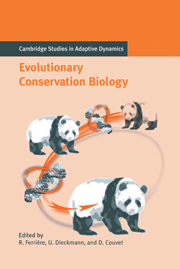Book contents
- Frontmatter
- Contents
- Contributing Authors
- Acknowledgments
- Notational Standards
- 1 Introduction
- Part A Theory of Extinction
- Part B The Pace of Adaptive Responses to Environmental Change
- Part C Genetic and Ecological Bases of Adaptive Responses
- Part D Spatial Structure
- Part E Community Structure
- 16 Coevolutionary Dynamics and the Conservation of Mutualisms
- 17 Ecosystem Evolution and Conservation
- 18 The Congener as an Agent of Extermination and Rescue of Rare Species
- 19 Epilogue
- References
- Index
- The International Institute for Applied Systems Analysis
18 - The Congener as an Agent of Extermination and Rescue of Rare Species
Published online by Cambridge University Press: 15 August 2009
- Frontmatter
- Contents
- Contributing Authors
- Acknowledgments
- Notational Standards
- 1 Introduction
- Part A Theory of Extinction
- Part B The Pace of Adaptive Responses to Environmental Change
- Part C Genetic and Ecological Bases of Adaptive Responses
- Part D Spatial Structure
- Part E Community Structure
- 16 Coevolutionary Dynamics and the Conservation of Mutualisms
- 17 Ecosystem Evolution and Conservation
- 18 The Congener as an Agent of Extermination and Rescue of Rare Species
- 19 Epilogue
- References
- Index
- The International Institute for Applied Systems Analysis
Summary
Introduction
Species with small population sizes and narrow distributions are represented in floras and faunas throughout the world. These species are vulnerable to extinction by natural processes and human disturbance. Many rare species contain ten populations or less, and some or all of these populations have only a few individuals (Box 18.1; see Schemske et al. 1994; Rhymer and Simberloff 1996).
Whereas there is considerable information on the roles of habitat alteration, interspecific competition, pest pressure, and inbreeding in species extinction (Chapters 5, 6, 9, and 15), only recently have we realized that hybridization also may jeopardize the existence of species. This possibility was recognized first by Harper et al. (1961). Its potential importance for both plants and animals was discussed by Rieseberg (1991) and Ellstrand (1992), and further considered by Levin et al. (1996) and Rhymer and Simberloff (1996).
The primary objective of this chapter is to discuss the role of abundant congeners in the extinction and salvation of rare species. First, I consider the factors that contribute to species contact (Section 18.2), and then interactions between rare species and congeners (Section 18.3). Examples of species threatened by hybridization (Section 18.4) follow. The outcome of hybridization is not always extinction, as we see in the stabilization of hybrid derivatives (Section 18.5) and the rescue of rare species through gene flow (Section 18.6).
Habitat Change and Species Contact
Contact between rare and common species may be facilitated by habitat alterations on different spatial scales.
- Type
- Chapter
- Information
- Evolutionary Conservation Biology , pp. 344 - 355Publisher: Cambridge University PressPrint publication year: 2004
- 2
- Cited by



